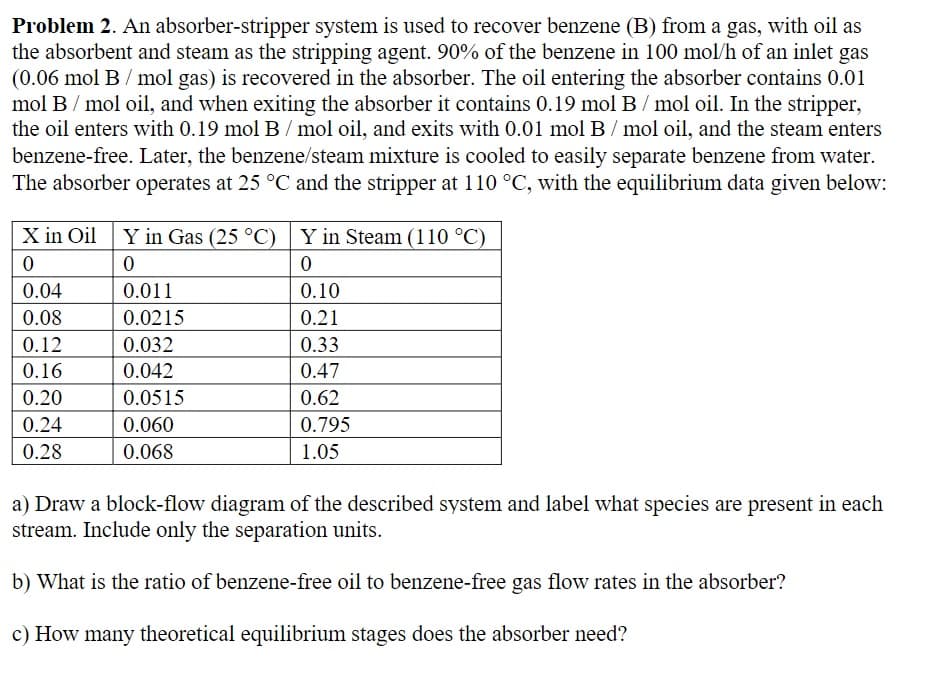Problem 2. An absorber-stripper system is used to recover benzene (B) from a gas, with oil as the absorbent and steam as the stripping agent. 90% of the benzene in 100 mol/h of an inlet gas (0.06 mol B /mol gas) is recovered in the absorber. The oil entering the absorber contains 0.01 mol B /mol oil, and when exiting the absorber it contains 0.19 mol B /mol oil. In the stripper, the oil enters with 0.19 mol B/mol oil, and exits with 0.01 mol B /mol oil, and the steam enters benzene-free. Later, the benzene/steam mixture is cooled to easily separate benzene from water. The absorber operates at 25 °C and the stripper at 110 °C, with the equilibrium data given below: X in Oil Y in Gas (25 °C) 0 0 0.04 0.08 0.12 0.16 0.20 0.24 0.28 0.011 0.0215 0.032 0.042 0.0515 0.060 0.068 Y in Steam (110 °C) 0 0.10 0.21 0.33 0.47 0.62 0.795 1.05 a) Draw a block-flow diagram of the described system and label what species are present in each stream. Include only the separation units. b) What is the ratio of benzene-free oil to benzene-free gas flow rates in the absorber? c) How many theoretical equilibrium stages does the absorber need?
Problem 2. An absorber-stripper system is used to recover benzene (B) from a gas, with oil as the absorbent and steam as the stripping agent. 90% of the benzene in 100 mol/h of an inlet gas (0.06 mol B /mol gas) is recovered in the absorber. The oil entering the absorber contains 0.01 mol B /mol oil, and when exiting the absorber it contains 0.19 mol B /mol oil. In the stripper, the oil enters with 0.19 mol B/mol oil, and exits with 0.01 mol B /mol oil, and the steam enters benzene-free. Later, the benzene/steam mixture is cooled to easily separate benzene from water. The absorber operates at 25 °C and the stripper at 110 °C, with the equilibrium data given below: X in Oil Y in Gas (25 °C) 0 0 0.04 0.08 0.12 0.16 0.20 0.24 0.28 0.011 0.0215 0.032 0.042 0.0515 0.060 0.068 Y in Steam (110 °C) 0 0.10 0.21 0.33 0.47 0.62 0.795 1.05 a) Draw a block-flow diagram of the described system and label what species are present in each stream. Include only the separation units. b) What is the ratio of benzene-free oil to benzene-free gas flow rates in the absorber? c) How many theoretical equilibrium stages does the absorber need?
Introduction to Chemical Engineering Thermodynamics
8th Edition
ISBN:9781259696527
Author:J.M. Smith Termodinamica en ingenieria quimica, Hendrick C Van Ness, Michael Abbott, Mark Swihart
Publisher:J.M. Smith Termodinamica en ingenieria quimica, Hendrick C Van Ness, Michael Abbott, Mark Swihart
Chapter1: Introduction
Section: Chapter Questions
Problem 1.1P
Related questions
Question
100%

Transcribed Image Text:Problem 2. An absorber-stripper system is used to recover benzene (B) from a gas, with oil as
the absorbent and steam as the stripping agent. 90% of the benzene in 100 mol/h of an inlet gas
(0.06 mol B /mol gas) is recovered in the absorber. The oil entering the absorber contains 0.01
mol B/mol oil, and when exiting the absorber it contains 0.19 mol B /mol oil. In the stripper,
the oil enters with 0.19 mol B/mol oil, and exits with 0.01 mol B / mol oil, and the steam enters
benzene-free. Later, the benzene/steam mixture is cooled to easily separate benzene from water.
The absorber operates at 25 °C and the stripper at 110 °C, with the equilibrium data given below:
X in Oil Y in Gas (25 °C) Y in Steam (110 °C)
0
0
0
0.04
0.08
0.12
0.16
0.20
0.24
0.28
0.011
0.0215
0.032
0.042
0.0515
0.060
0.068
0.10
0.21
0.33
0.47
0.62
0.795
1.05
a) Draw a block-flow diagram of the described system and label what species are present in each
stream. Include only the separation units.
b) What is the ratio of benzene-free oil to benzene-free gas flow rates in the absorber?
c) How many theoretical equilibrium stages does the absorber need?
Expert Solution
This question has been solved!
Explore an expertly crafted, step-by-step solution for a thorough understanding of key concepts.
This is a popular solution!
Trending now
This is a popular solution!
Step by step
Solved in 7 steps with 2 images

Recommended textbooks for you

Introduction to Chemical Engineering Thermodynami…
Chemical Engineering
ISBN:
9781259696527
Author:
J.M. Smith Termodinamica en ingenieria quimica, Hendrick C Van Ness, Michael Abbott, Mark Swihart
Publisher:
McGraw-Hill Education

Elementary Principles of Chemical Processes, Bind…
Chemical Engineering
ISBN:
9781118431221
Author:
Richard M. Felder, Ronald W. Rousseau, Lisa G. Bullard
Publisher:
WILEY

Elements of Chemical Reaction Engineering (5th Ed…
Chemical Engineering
ISBN:
9780133887518
Author:
H. Scott Fogler
Publisher:
Prentice Hall

Introduction to Chemical Engineering Thermodynami…
Chemical Engineering
ISBN:
9781259696527
Author:
J.M. Smith Termodinamica en ingenieria quimica, Hendrick C Van Ness, Michael Abbott, Mark Swihart
Publisher:
McGraw-Hill Education

Elementary Principles of Chemical Processes, Bind…
Chemical Engineering
ISBN:
9781118431221
Author:
Richard M. Felder, Ronald W. Rousseau, Lisa G. Bullard
Publisher:
WILEY

Elements of Chemical Reaction Engineering (5th Ed…
Chemical Engineering
ISBN:
9780133887518
Author:
H. Scott Fogler
Publisher:
Prentice Hall


Industrial Plastics: Theory and Applications
Chemical Engineering
ISBN:
9781285061238
Author:
Lokensgard, Erik
Publisher:
Delmar Cengage Learning

Unit Operations of Chemical Engineering
Chemical Engineering
ISBN:
9780072848236
Author:
Warren McCabe, Julian C. Smith, Peter Harriott
Publisher:
McGraw-Hill Companies, The